Slave Leia Sells? Amy Schumer, Boy Toys, and the Star Wars Fandom Double Standard
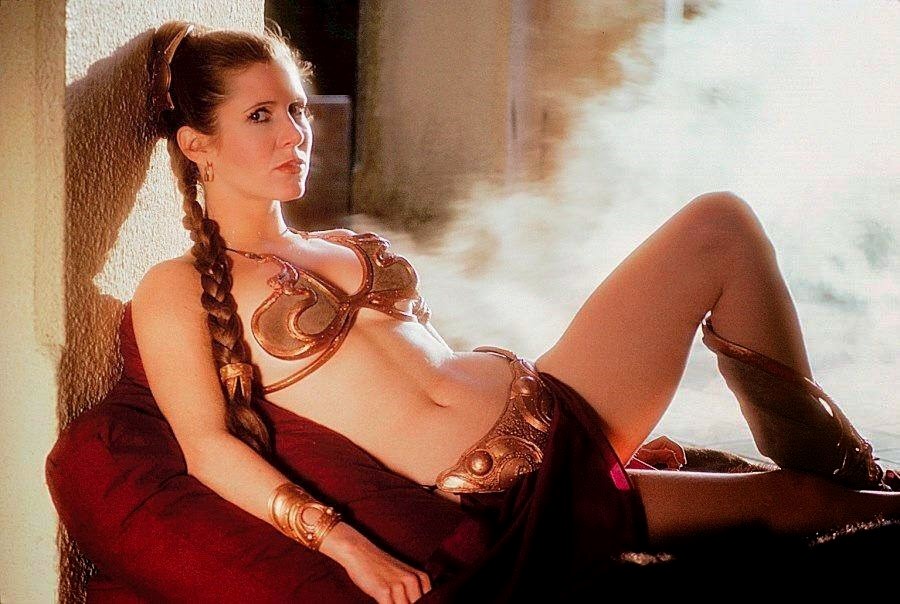 One week after we celebrated our first glimpse of Leia rocking a commanding costume in the behind-the-scenes reel from the The Force Awakens panel at San Diego Comic-Con, which followed two outstanding teasers that proved a mega-franchise movie doesn’t need to stoop to sexualizing any of its characters to generate interest, social media was atwitter over Slave Leia. First, a local Fox station in Philadelphia ran a segment called “Star Wars Action Figure Has Parents Furious” after a father of two daughters took issue with finding Black Series 6” Slave Leia action figures marked “ages 4 and up” in the toy aisle at Target. Later, GQ magazine released images of feminist comedienne Amy Schumer posed provocatively in the Slave Leia costume alongside other famous Star Wars characters.
One week after we celebrated our first glimpse of Leia rocking a commanding costume in the behind-the-scenes reel from the The Force Awakens panel at San Diego Comic-Con, which followed two outstanding teasers that proved a mega-franchise movie doesn’t need to stoop to sexualizing any of its characters to generate interest, social media was atwitter over Slave Leia. First, a local Fox station in Philadelphia ran a segment called “Star Wars Action Figure Has Parents Furious” after a father of two daughters took issue with finding Black Series 6” Slave Leia action figures marked “ages 4 and up” in the toy aisle at Target. Later, GQ magazine released images of feminist comedienne Amy Schumer posed provocatively in the Slave Leia costume alongside other famous Star Wars characters.
Judging by the headlines across media outlets, it would appear significant segments of fandom are irate with the local station and the father who instigated its report, as well as with Schumer, who allegedly earned the “ire” of Disney|Lucasfilm. To date, the official Star Wars Twitter account has issued a one-line response, lacking in any actual corporate-level indignation, to fans who reacted to the Schumer images and held Disney|Lucasfilm accountable for them. A short statement from Disney was also released to Variety, along with the admission that parodying the franchise is covered under fair use.
[tweet_embed id=621826707830366208]No official response was given to the local Fox piece, but that is likely because this isn’t the first time Lucasfilm or Disney have heard concerns from parents regarding the Slave Leia Black Series action figure. The fetishizing of the character has been brought up repeatedly to Lucasfilm employees, including Story Group member Rayne Roberts during the What Princess Leia Means To Me panel at Celebration Anaheim.
The week-long kerfuffle brought together a myriad of fandom reactions that highlight the pervasive and persistent double standard in regards to women and their sexuality. Those outraged about the toy aren’t necessarily bothered by the GQ pictures, or vice versa, but quite a bit of intersectionality exists in those expressions of displeasure. Not only that, much of the outrage seemingly stems from incomplete understandings of the numerous factors at play, ranging from the hyper-gendering of toys to the legalities of transformative use of intellectual property. Before addressing the double standard, though, it’s important to consider all aspects of the context.
Slave Leia in Context
I don’t take issue with the Slave Leia costume itself, which I have written about at great length. My article Does Slave Leia Weaken or Empower Women details how Return of the Jedi and Carrie Fisher don’t allow the costume to demean the character. Not only does Leia win, but she slays her oppressor Jabba with the chains that bind her. Female cosplayers have taken the powerful message embedded in the character and worn the costume with pride. For the record, I would wear the costume with pride, too, given the opportunity.
The fact that the slave attire serves valid storytelling and characterization purposes within the movie, however, does not somehow automatically give a free pass to all the ways Lucasfilm or its licensees have exploited the costume and its image since then. All too often, Slave Leia has been the only costume used to represent Leia – even in products expressly created for young children like LEGOs – despite her much greater role in the saga as a leader and warrior.
[tweet_embed id=553584052398481408]This dynamic is compounded when considered in light of Padmé’s midriff baring in Attack of the Clones, which is affirmatively objectification that serves no storytelling purpose, and like her daughter this imagery seems to be used for licensed material in far greater proportion than the character’s on-screen time in the scanty outfit. Star Wars Insider 144 featured my article on Leia as an empowered female archetype, with Slave Leia on the cover; this did not come as a surprise after mid-riff butt-pose Padmé graced the cover of Issue 142, which featured my piece on the Naboo monarch’s legacy as a strong female character. Personally, I don’t believe either cover reflects the message in my featured articles, but they do provide further evidence of the mindset, which still existed in 2013, that Slave Leia and Midriff Padmé were necessary to sell the female characters of Star Wars. Sell the franchise to whom, though?
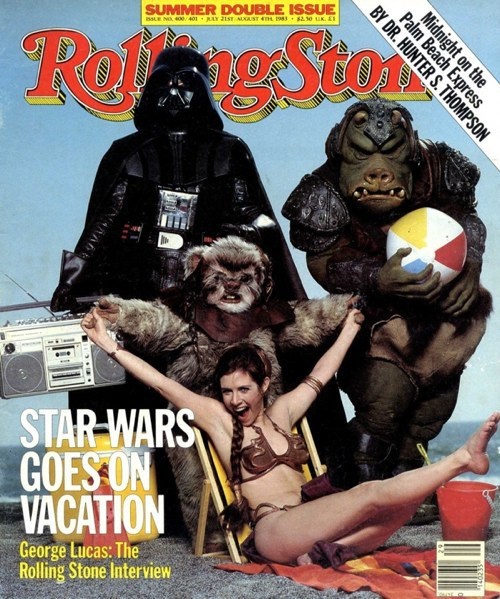 It’s no mystery where this mentality originates: the resources on the creation of the Slave Leia attire in 1982 make quite clear that this imagery was included to titillate the young men in the audience. The book Star Wars Costumes: The Original Trilogy by Brandon Alinger reveals the awkward viewpoints of Richard Marquand, who thought Carrie Fisher was “incredibly sexy,” and Nilo Rodis-Jamero, who relates his personal crush on Fisher in the same excerpt that details the events of her body casting, where she had to go topless and wisely brought along friend Penny Marshall. It’s almost comical to imagine a book passage discussing the body casting for Hayden Christensen’s codpiece or him standing in full frontal nudity before a female costume designer with a crush on him. Alinger’s book suggests that Lucas wasn’t convinced he could persuade Fisher on the costume; there is plenty of evidence that actresses have had little choice, until the last decade or so, to refuse.
It’s no mystery where this mentality originates: the resources on the creation of the Slave Leia attire in 1982 make quite clear that this imagery was included to titillate the young men in the audience. The book Star Wars Costumes: The Original Trilogy by Brandon Alinger reveals the awkward viewpoints of Richard Marquand, who thought Carrie Fisher was “incredibly sexy,” and Nilo Rodis-Jamero, who relates his personal crush on Fisher in the same excerpt that details the events of her body casting, where she had to go topless and wisely brought along friend Penny Marshall. It’s almost comical to imagine a book passage discussing the body casting for Hayden Christensen’s codpiece or him standing in full frontal nudity before a female costume designer with a crush on him. Alinger’s book suggests that Lucas wasn’t convinced he could persuade Fisher on the costume; there is plenty of evidence that actresses have had little choice, until the last decade or so, to refuse.
Even back in 1983, Carrie Fisher identified publicly the reasons why Leia had to strip down for the third movie in an interview with Rolling Stone, where she is playfully depicted in the Slave Leia costume, and totally out of storytelling context, on the cover. From Emily Asher-Perrin’s fantastic piece on the Rolling Stone article at TOR.com:
What’s shocking is that Fisher starts the interview by mentioning that many fans of the films view her character as “some kind of space bitch.”
These days, with Leia’s firmly entrenched position in the Great SF Film Pantheon, it’s hard to imagine that people were so callous about her character. But according to Fisher, the Princess’ hard road in the rebellion made her less than thrilling to fans:
“She has no friends, no family; her planet was blown up in seconds—along with her hairdresser—so all she has is a cause. From the first film, she was just a soldier, front line and center. The only way they knew to make the character strong was to make her angry.”
So Fisher would have preferred Leia to be scripted with a bit more nuance, then. Not just a leader, not just an angry woman who lost her home, but someone who had a few extra emotions packed in there. … [I]t’s Fisher’s thoughts on Return of the Jedi that really spell out how her character was considered from a fan-pleasing standpoint:
“In Return of the Jedi, she gets to be more feminine, more supportive, more affectionate. But let’s not forget that these movies are basically boys’ fantasies. So the other way they made her more female in this one was to have her take off her clothes.”
Ouch. Alright, plenty of us ladies would argue about Star Wars being strictly a boy’s fantasy, but Fisher is correct in context; at the time that Star Wars originally came out, the population certainly agreed that these films were made primarily for kids and teenage boys, and they were marketed as such. So her point about being in the bikini is even more valid—it is hard to suggest that costume change is there for anything but male gaze.
The Making of Return of the Jedi by J.W. Rinzler clarifies that Fisher had voiced concerns about Leia’s character, in the hope that she would express more emotional range than anger/kick-ass girl; perhaps cry she had suggested. The creative team decided to soften the character by way of the slave bikini instead. Screenwriter Lawrence Kasdan worried that both Han’s and Leia’s arcs were being sidelined after The Empire Strikes Back and offered up the suggestion that Jabba die at Leia’s hands, giving her time in the costume powerful meaning. 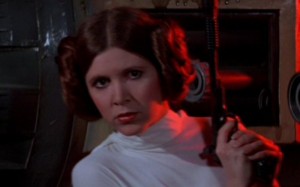 While Costumes notes Lucasfilm initially tread carefully with publicity and action figures involving Slave Leia after early public reaction to the costume, the Rolling Stone cover is one of the early signs of the slow burn toward overexposure. Only recently, though, have we reached a cultural firestorm around the costume and the corresponding discussions about its use in storytelling and the external way the franchise turned it into a tool of objectification. (For an excellent resource on the topic, see SF Signal’s July 28, 2014 roundup.)
While Costumes notes Lucasfilm initially tread carefully with publicity and action figures involving Slave Leia after early public reaction to the costume, the Rolling Stone cover is one of the early signs of the slow burn toward overexposure. Only recently, though, have we reached a cultural firestorm around the costume and the corresponding discussions about its use in storytelling and the external way the franchise turned it into a tool of objectification. (For an excellent resource on the topic, see SF Signal’s July 28, 2014 roundup.)
Princess Leia is the gold standard for strong female characters; I’ve said as much repeatedly. My respect for George Lucas as her creator, however, doesn’t mean I must ignore his missteps in regards to protecting her character in terms of licensing, marketing, or how she was portrayed in the Expanded Universe. The midriff baring in the Prequel Trilogy and Ahsoka Tano’s original tube top outfit for The Clone Wars confirm a blind spot in regards to sexualization of female characters has existed in the franchise.
Earlier this year on the Celebration Leia panel, Lucasfilm Story Group’s Rayne Roberts asserted that Lucas never intended to demean or degrade women, a point which I believe, while Lucasfilm books editor Jen Heddle explained how the confusion over sexualization of Slave Leia can permeate the storytelling culture spawned by men who grew up with the Original Trilogy in their impressionable teenage years. 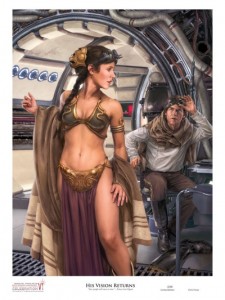 In discussion with the all-male Marvel comics team, the topic of Han’s reaction to the slave bikini became a source of contention, with Heddle asserting Han would not find the bikini sexy. This Celebration VI art show piece, selected and endorsed by the franchise to be sold at the convention, is a visual representation of sexual tension after the Sarlacc pit escape imagined in many a fanboy’s mind, including apparently some of Marvel’s staff. Leia appears to be relishing the revelation of her new “sexy attire” to recovering-from-carbonite-freezing-blindness Han. But how can the costume not be a representation of Leia’s oppression to the man who loves her? Within the story, Han must hate the bikini because of what it means to her. While women wear the costume proudly, none of them parade around with Jabba tongue goo or sand crusted in every crack. Ultimately, pieces like the Celebration VI art are sanctioned works that undermine the good ways Slave Leia was used within the story as a symbol of triumph over a form of oppression, and they reinforce the sexualization and objectification of Leia solely for titillation.
In discussion with the all-male Marvel comics team, the topic of Han’s reaction to the slave bikini became a source of contention, with Heddle asserting Han would not find the bikini sexy. This Celebration VI art show piece, selected and endorsed by the franchise to be sold at the convention, is a visual representation of sexual tension after the Sarlacc pit escape imagined in many a fanboy’s mind, including apparently some of Marvel’s staff. Leia appears to be relishing the revelation of her new “sexy attire” to recovering-from-carbonite-freezing-blindness Han. But how can the costume not be a representation of Leia’s oppression to the man who loves her? Within the story, Han must hate the bikini because of what it means to her. While women wear the costume proudly, none of them parade around with Jabba tongue goo or sand crusted in every crack. Ultimately, pieces like the Celebration VI art are sanctioned works that undermine the good ways Slave Leia was used within the story as a symbol of triumph over a form of oppression, and they reinforce the sexualization and objectification of Leia solely for titillation.
With the first generation of Star Wars fans now creating movies, including in the franchise that sparked their enthusiasm for storytelling, the influence of Slave Leia becomes even more relevant. Michael Kaplan, costume designer for The Force Awakens, answered criticism of the infamous Alice Eve bra scene for the J.J. Abrams directed Star Trek Into Darkness as follows:
“Last time, Zoe needed to wear underwear, and this time it was Alice Eve’s turn. You know, it’s a rather large male fanbase, and JJ wanted to appeal to that.”
No doubt Kirk has always been an heroic ass, but glorifying a situation where a male officer acts inappropriately toward a female subordinate in an era where more and more real-life sexual misconduct cases come to light each day is senseless and irresponsible as human beings and storytellers. And no doubt, the character of Princess Leia would have told Kaplan and Abrams so. Ultimately, Abrams and co-writer Damon Lindelof ended up apologizing for designing a gratuitous scene. The all-male production leadership on Star Trek Into Darkness, without perspectives like Roberts’ and Heddle’s at the table, illustrates how privilege and blinders can spin up a vacuum where storytelling fosters oppression in a franchise like Star Trek that is grounded in the hope for a better, more enlightened future. Sadly, it’s hardly the only instance of gratuitous sexualizing and objectification of women created by a team weaned on the breast of the Star Wars Original Trilogy, where “there was no underwear in space.”
If Slave Leia imagery could serve its goal of crass pandering to a certain target demographic without impacting the broader franchise in anyway, it might still be problematic but at least it would be harmless to the brand. The reality, though, is not that simple. During a podcast discussion a few years ago on Feminism and Star Wars: The Sexualization of Female Characters in Star Wars, I pointed out the discrepancy between the internal narrative and external uses of the Slave Leia imagery, particularly emphasizing how it can inhibit the potential growth for the franchise when prospective new fans notice sexualized imagery and decide the sort of franchise that would objectify a female character that way isn’t for them. Longtime Star Wars fans sometimes forget that not everyone sees the movies first and the toys, merchandise, and marketing later. Some people’s first experience with Star Wars is seeing a toy on a shelf or a piece of art on a book jacket or magazine cover. For people who aren’t intimately familiar with the storytelling and characterization payoff of Leia’s enslavement in Return of the Jedi, what will they think when they see Slave Leia or Midriff Padmé repeatedly paraded out as the ambassador of the female characters in the franchise?
This past weekend I had the pleasure of attending a book signing of Ultimate Star Wars for Barnes & Noble’s Star Wars Saturday, part of their Pop Culture Month promotion. The staff had arranged all their available Star Wars merchandise around the signing table, including life-size standees, Funko’s Pop collection, and Hasbro’s Black Series 6” action figures. After mingling with a few of the attendees I sidled over to the Funko display in search of a Leia as Boushh Unmasked. Not surprisingly, there were more girls than boys in attendance at the event – the fankid gender ratio on my Ultimate Star Wars book tour also had been evenly split, with a few times skewing more towards fangirls. Two young ladies joined me, checking for potential new items for their collection. That was when my gaze drifted to the Hasbro display, with two different options of Luke, a Han, a Stormtrooper, Greedo, Boba Fett, Obi-Wan, and Princess Leia (Jabba’s Slave). These fangirls were under ten, and my gut reaction was to grab the Slave Leia toy and stuff her in the back. Instead I redirected them to the only other female collectible within sight, the Funko Leia Boushh Masked version. The genderless figure didn’t strike a chord with either girl; both girls looked at Boushh unaffected before putting it back on the shelf. As the pre-signing author talk went along, I learned the girls were fans by way of The Clone Wars and Star Wars Rebels. Is Slave Leia really the version of Original Trilogy Leia to inspire these young fangirls to spread their wings into other eras of the Star Wars saga? Plenty of empirical evidence exists that quantifies how over-sexualized characters impact the development of girls. Either the franchise is a Force for Change or it isn’t; Slave Leia without any other female alternative in the toy aisle is most definitely not progressive.
The Black Series and the News Report in Context
In terms of the Black Series Slave Leia figure itself, several interesting points have been brought up by entrenched fans who collect. They almost all note that the 6” figures have a higher price point and are aimed at the collector market, not the toy market. If this is true, though, then it would seem to support rather than refute the concerns raised by the father in the television report; if a product isn’t aimed at kids making impulse purchases in a toy aisle at the local store, why is it pegwarming at Target in the first place? There also has been quite a bit of rehashing of the poor face sculpt on the Slave Leia, cited as the reason many collectors refuse to buy this version. While this may be true, it’s irrelevant to the objectification and sexualization concerns Slave Leia presents.
Other fans have focused on lambasting the television report, apparently viewing it as some sort of insult to the franchise. These comments range from seeking to pick apart the journalism tactics of the news station or its reporting team to resorting to ad hominems like calling the father a “prude” or “idiot” and rehashing the explanations of how Slave Leia is a triumph of portraying strong female characters. These sorts of strawman arguments can be found on full display in this article on Entertainment Nut.
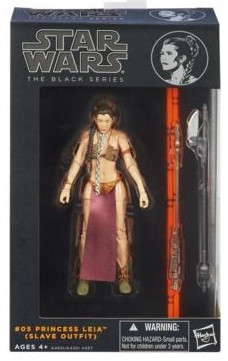 Boiled down to the core of the events: a father took his kids to the toy aisle in a Target and found Slave Leia hanging on pegs. He did not understand the context of the story, nor is he required to understand the context of every franchise tie-in toy before he shops. We’re not talking about She-Ra, where the franchise has only one costume to pick from. This is Leia; she has any number of amazing costumes. The father’s quibble isn’t with the costume in the film, but rather it showing up in the toy aisle. What most of the detractors of the report fail to mention is that the reporter speaks to a mother who does understand the context of the costume and she agrees with the father.
Boiled down to the core of the events: a father took his kids to the toy aisle in a Target and found Slave Leia hanging on pegs. He did not understand the context of the story, nor is he required to understand the context of every franchise tie-in toy before he shops. We’re not talking about She-Ra, where the franchise has only one costume to pick from. This is Leia; she has any number of amazing costumes. The father’s quibble isn’t with the costume in the film, but rather it showing up in the toy aisle. What most of the detractors of the report fail to mention is that the reporter speaks to a mother who does understand the context of the costume and she agrees with the father.
Nor can the overarching contemporary social controversies surrounding female toys be ignored. In just the past several months, multiple problematic instances have occurred. Black Widow was removed from toys and replaced with male superheroes even though she was clearly the character depicted in the Avengers: Age of Ultron scene the toy relates to. The raptor gang from Jurassic World was genderswapped to male on toy packaging even though the conceit of the entire franchise is that the dinosaurs are female. Numerous online campaigns have ramped up around gendered toys, from #WeWantLeia and #WeWantWidow to viral videos that helped convince corporations like LEGO, Disney Store and Toys R Us to change how they code toys by gender. Within Star Wars, we witnessed the backlash after the New York Toy Fair roll out with characters Hera and Sabine missing from the Star Wars Rebels action figures, and quite a few other things as well. At the Rebel Women Who Fought The Clone Wars panel at Star Wars Celebration hosted by Dave Filoni, when parents asked how to affect change for their daughters in the realm of toys they were told by Rayne Roberts to “go online and make noise” while Filoni added that fans have the power to create change.
And what this father did was take the panel’s advice: he expressed concern there are only Slave Leias in the toy aisle. Why do people react so vociferously to his reasonable request to put adult-aimed merchandise somewhere adults can see it and not his young daughters? Parents have every right to speak up when they find content they believe is troublesome in the toy aisle, and desiring not to see famous brands like Star Wars with sexualized and/or objectified toys isn’t exactly an outrageous expectation.
Ultimately, Slave Leia as representation of a strong female character is the weakest defense of the action figure. Across her entire arc in the Original Trilogy, Leia’s time as Jabba’s slave is inconsequential to her character. She’s a princess of oppressed people; she’s a rebel leader who can fly a number of vehicles, shoot a blaster with precision, and brief multiple squadrons of pilots. She is also a woman falling in love and willing to risk it all to save the man she gave her heart to. And if that’s not impressive enough, she can mediate with primitive savages, creating an ally for the Rebellion that proves crucial in the destruction of the second Death Star. These are the character arcs that I broke down for my two-page spread on Princess Leia for Ultimate Star Wars. Leia in the slave costume earned a mention in the timeline sidebar, for one remarkable event: when she strangles Jabba. Why do I think it’s remarkable? Not because she muscles him to death, but because for all intents and purposes she probably harnessed the Force to do it – there is the simple matter of physics working against her. The costume isn’t part of Leia’s character; it was someone she was forced to be.
The Double Standard
Which brings me to the viral marketing campaign launched by Amy Schumer in advance of her movie Trainwreck, which opened last weekend. She might be one of comedy’s best answers to sexism in the same way Chris Rock has tackled racism head-on over his comedic career. Schumer is unapologetic, bawdy, and keenly aware of the idiosyncrasies of pop culture. Her Star Wars parody photo shoot had been teased on Entertainment Tonight before the cover was released and resulted in the internet firestorm.
As the fandom reaction unfolded, though, it was notable how ill-informed many fans were about the legal implications of what transpired. First and foremost, neither Lucasfilm nor Disney had a say in the creation or use of Schumer’s Star Wars parody, in the same way neither Marvel nor Lincoln have any claim to stop Saturday Night Live from mocking the former’s roles for female characters and the latter’s car commercials. GQ magazine is under the umbrella of media conglomerate Conde Nast, which has a team of lawyers with expertise in trademark and copyright laws. The simplified explanation of parody is “[a] form of speech protected by the First Amendment as a “distorted imitation” of an original work for the purpose of commenting on it.” (via The Free Dictionary: Legal Dictionary) Trademark and copyright protection only come into play when the parody causes market harm to the ability to profit from the original work or tarnishment that directly impacts the trademark or copyright holder. Any claim against Schumer’s photos would be particularly weak because plenty of examples exist of Lucasfilm and Disney themselves parodying Star Wars in ways that were deemed offensive by some, from the Family Guy Star Wars specials with Herbert the elderly pedophile in the role of Obi-Wan to Star Wars Weekends erstwhile Hyperspace Hoopla, where Slave Leia, Midriff Padmé, and Ahsoka Tano were made to dance suggestively.
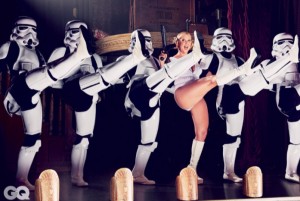 An interesting byproduct of the GQ photos was the cosplayer scare tactic, where multiple parties suggested Disney|Lucasfilm will begin to crack down on fan cosplayers as a result of Schumer’s actions. A policy shift in regards to fan cosplayers interacting with branded products at official events has occurred in recent months, but that change took place before the GQ photos and for legal and financial reasons unrelated to a celebrity’s public interaction with the franchise.
An interesting byproduct of the GQ photos was the cosplayer scare tactic, where multiple parties suggested Disney|Lucasfilm will begin to crack down on fan cosplayers as a result of Schumer’s actions. A policy shift in regards to fan cosplayers interacting with branded products at official events has occurred in recent months, but that change took place before the GQ photos and for legal and financial reasons unrelated to a celebrity’s public interaction with the franchise.
Some fans seemed to leap to protecting Star Wars’ honor and integrity in their outrage at Schumer. Often, though, the whole point of parody is to embarrass a government organization, a corporation, or a group of people into reassessing their own integrity and honor. Schumer is far from the first star to join dancing stormtroopers; William Shatner irreverently joined a kickline during the presentation of George Lucas’ AFI Lifetime Achievement Award and Neil Patrick Harris’s Oscar hosting stint had dancing stormtroopers. Like Shatner and Harris, Schumer’s poses create “distorted imitations” of the iconic franchise. Most fans who’ve spoken up, though, aren’t bothered simply by Schumer bootstrapping on the fame of Star Wars for her own self-promotion, but rather by the sexualized content.
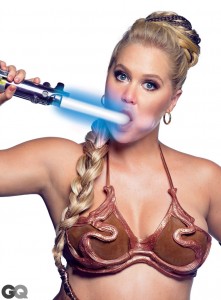 Without a doubt, the provocative sexuality of some of the photos and Schumer’s appearance in the slave bikini make clear that she made the images “for the purpose of commenting on [the original work]” of Star Wars. Amy Schumer grew up in the Star Wars era, where backlash both within Lucasfilm and external to Lucasfilm defined Star Wars as a boys’ property. The rise in the use of the Slave Leia costume as non-contextual means to sell franchise products via sexualization of the character directly coincides with the claiming of Star Wars as a boys’ franchise and a rise in backlash against women. When Amy Schumer chooses to don the Slave Leia costume and puts the lightsaber – the ultimate science-fiction phallic symbol – in her mouth, then casts a smirk that suggests she is overtly enjoying the act, something Leia never could do, the comedienne takes back ownership of the sexuality of one of the most prominent and important female characters in pop culture, and in doing so she takes control of her own sexuality as well. Her pose in bed inverts the usual post-coital imagery with a man puffing on a cigarette to infer sexual satisfaction while also usurping the male fantasy of having two women at once. In using Threepio and Artoo, which are patterned more asexual despite their default as masculine droids, Schumer sexualizes characters in a way that makes many fans uncomfortable. The unspoken commentary presented by the photos are the following questions:
Without a doubt, the provocative sexuality of some of the photos and Schumer’s appearance in the slave bikini make clear that she made the images “for the purpose of commenting on [the original work]” of Star Wars. Amy Schumer grew up in the Star Wars era, where backlash both within Lucasfilm and external to Lucasfilm defined Star Wars as a boys’ property. The rise in the use of the Slave Leia costume as non-contextual means to sell franchise products via sexualization of the character directly coincides with the claiming of Star Wars as a boys’ franchise and a rise in backlash against women. When Amy Schumer chooses to don the Slave Leia costume and puts the lightsaber – the ultimate science-fiction phallic symbol – in her mouth, then casts a smirk that suggests she is overtly enjoying the act, something Leia never could do, the comedienne takes back ownership of the sexuality of one of the most prominent and important female characters in pop culture, and in doing so she takes control of her own sexuality as well. Her pose in bed inverts the usual post-coital imagery with a man puffing on a cigarette to infer sexual satisfaction while also usurping the male fantasy of having two women at once. In using Threepio and Artoo, which are patterned more asexual despite their default as masculine droids, Schumer sexualizes characters in a way that makes many fans uncomfortable. The unspoken commentary presented by the photos are the following questions:
If the sexualized droids make people uncomfortable, why weren’t those same people also uncomfortable with Leia’s sexualization when none of her male counterparts received similar treatment?
Despite the fact that the story managed to empower the character, was sexualizing Leia necessary or is it a product of systemic sexism in Hollywood?
Ironically, despite being topless for her bedroom shot with Threepio and Artoo, Schumer’s hair is arranged in such a way, and the bed covers are pulled up, so that she actually reveals far less skin in this photo than a full-body image of Slave Leia. The comedienne is making a potent statement about how contextual sexualizing of characters for the intention of marketing can be problematic.
 Schumer is a woman reveling in her sexuality and the kind of privilege that previously has been solely ascribed to men in Hollywood. At the same time, she literally borrowed from the playbook for Disney|Lucasfilm’s rollout for The Force Awakens with a dribbling of screen shots, a video, and accompanying side articles all in advance of the magazine’s release. All of this hype was done in service of the bottom line for her feminist take on the rom-com, the Star Wars fandom gave Schumer and GQ exactly what they wanted.
Schumer is a woman reveling in her sexuality and the kind of privilege that previously has been solely ascribed to men in Hollywood. At the same time, she literally borrowed from the playbook for Disney|Lucasfilm’s rollout for The Force Awakens with a dribbling of screen shots, a video, and accompanying side articles all in advance of the magazine’s release. All of this hype was done in service of the bottom line for her feminist take on the rom-com, the Star Wars fandom gave Schumer and GQ exactly what they wanted.
In another nod to her comedic intuition, Schumer posed for a magazine aimed at gentleman precisely because Star Wars and the fandom has created an identity for itself as the fanboys-grown-into-gentleman franchise, despite fangirls protesting they have been here all along. Nothing highlights this whole ridiculous mindset better than grown men berating another man for trying to do right by his female daughters over a toy. Whether it’s discussing Black Series Slave Leia or Amy Schumer, some fans disparaged and discounted the viewpoints of those who they have deemed “outsiders.” Name-calling and belittling someone with a different viewpoint that challenges one’s own is a popular tactic of Gamergate; it was also a common tactic back in the early internet days of Star Wars message boards where women were attacked and chased from the fandom. Bloggers, podcasters and social media regulars in Star Wars fandom circles, most of whom, spent hours of their own time picking apart their first impressions of The Force Awakens’ teasers and behind-the-scene reels belittled journalists, fathers, mothers and daughters for expressing their own “first impressions” of the franchise. Attack the reporter, the father, the comedienne, or the new fan as a bad person and that somehow validates the opinion of the entrenched fandom. For the fandom to truly grow in the future, it must move away from these kinds of tactics and embrace all perspectives on Star Wars – even the ones that might make us a little bit uncomfortable.
Our Expanding Fandom
Unfortunately for Lucasfilm the franchise has never worked harder than it is currently at recognizing female fans and their concerns. In an era when they are trying to grow their fanbase in all demographics, last week’s Slave Leia kerfuffle shines a light on Lucasfilm’s history that the company’s new leadership is trying to reconcile, so much so that Kathleen Kennedy brought up the topic of female characters in Star Wars at her panel at Celebration Anaheim and announced she had made it her mission to elevate the roles for women. Kennedy has hired an impressive and diverse team of women and men to serve as the Star Wars Story Group and moved Lynwen Brennan into the role of Lucasfilm General Manager to focus the corporation’s “strategic vision.”
Star Wars is on its way up, from Daisy Ridley, Gwendolyn Christie, Lupita N’yongo and other notable women joining the cinematic universe in game-changing roles to the breadth of female characters appearing in the Marvel comics, not to mention the incredibly nuanced storytelling with a diverse cast of characters on Star Wars Rebels. But the franchise still minimizes women in many ways. Fans have not missed the regressive sacrificing of their limited string of strong female characters to serve the arcs of their pantheon of male characters in three consecutive adult novels. Other effects are seemingly more benign but not unnoticed, like the reduction of female featured bloggers at the face of the franchise StarWars.com over the last year from 22 percent down to a dismal 11 percent.
What I believe is important is Celebration Anaheim’s message of family, which truly is the foundation of Star Wars from the beginning. The moment we put Star Wars on a pedestal beyond reproach or parody will be the moment it will begin to fail. If we consider ourselves a Star Wars family, then we must accept our benevolent folkstory-weaving grandfather’s faults, laugh at our weird sister’s off-color jokes, empathize with our new uncle’s ignorance about our family history, and protect our children’s interest above all else.
Tricia Barr took her understanding of brand management and marketing, mixed it with a love of genre storytelling, and added a dash of social media flare to create FANgirl Blog, where she discusses Star Wars, fandom, and strong female characters. She is one of four authors of Ultimate Star Wars from DK Publishing, has written several feature articles for Star Wars Insider magazine and is a contributor for Her Universe’s Year of the Fangirl. Her FANgirl opinions can be heard on the podcasts Hyperspace Theories and RebelForce Radio Presents Fangirls Going Rogue.
Tricia Barr’s novel, Wynde, won the 2014 Independent Publisher Book Award Gold Medal for Best Science Fiction/Fantasy/Horror Ebook. She was also part of Silence in the Library’s successful all-female creator science fiction and fantasy anthology Athena’s Daughters, which is available now. For excerpts and tales of her adventures in creating a fictional universe, hop over to TriciaBarr.com.
For updates on all things FANgirl follow @FANgirlcantina on Twitter or like FANgirl Zone on Facebook. At times she tries the Tumblr.
- Hyperspace Theories: Bad Luck Ghorman - June 2, 2025
- Hyperspace Theories: One Year Later as ANDOR Kicks Off Season Two - May 15, 2025
- REVIEW: Tales of the Underworld - May 4, 2025











A well written, unbiased, spot-on analysis of this issue. I’m in my late 30s having grown up with and continue to be obsessed with Star Wars, of course had a crush on slave Leia in my adolescence, and now have a 3 year old daughter. I can relate to all parts of this post.
The Star Wars universe is fortunate to have you a part of it. Keep up the good work!
Great article Tricia. It’s good to hear an educated and trusting opinion from someone who cares about the Star Wars fandom and its future. I believe that Star Wars is in good hands overall and I believe that people will always take what they will of the franchise trying to twist and turn it into something it is or isn’t. Thanks for the read.
Fantastic article. Thank you on behalf of all conflicted fangirls!
Pingback:Episode CXXV: Huttslayer | Full Of Sith
Pingback:Tricia Talks Marvel’s Princess Leia on Mos Eisley Comicport « FANgirl Blog
Pingback:The Parity Problem, or Why Padmé is the Best Character in the Prequels | Eleven-ThirtyEight
Pingback:TWG Roundup: Star Wars Footwear, Fan Creations, and More! | The Wookiee Gunner
Pingback:The Force Awakens Girl Power Marketing In Full Swing | FANgirl Blog
Pingback:So long, Slave Leia. It's Slayer Leia now. | Our Ladies and Gentle Men
Pingback:So long, Slave Leia. It's 'Slayer Leia' now - News
Pingback:NewsCheek » So long, Slave Leia. It’s ‘Slayer Leia’ now
Pingback:Disney To Retire All Slave Leia Merchandise In The Future | Virallery
Pingback:So long, Slave Leia. It's 'Slayer Leia' now | App Showcase Wordpress Theme
Pingback:Disney To Retire All Slave Leia Merchandise In The Future
Of Amy Schumer’s photospread, you said she, “takes back ownership of the sexuality of one of the most prominent and important female characters in pop culture, and in doing so she takes control of her own sexuality as well.” While I can agree that it can be seen that way in very intellectual light, I have to say that I don’t agree that she “took back ownership” of the character’s sexuality. As a long-time fanfic writer, beta-reader, and reviewer/editor, I have read far too many stories with Slave Leia and what she went through in between being caught by Jabba and Luke’s arrival. Lucasfilm opened that door with “Tales from Jabba’s Palace” where the events of the rescue of Han were told from the points of view of the residents of Jabba’s palace. In one short story, Jabba sends Leia to Fett for the evening, to reward him for being the one to capture Leia trying to rescue Han. Even though the Fett in that novel did nothing to Leia because his own honor code would not let him do so, he made a point of “look[ing] at her for a long time. She was *worth* looking at.”
Ever since then, fanfic writers have written up a slew of stories where Leia’s night of enslavement doesn’t pass so peacefully or uneventfully. The worst ones are stories where the rescue does not happen at all because Luke gets killed by the rancor, or Mara pulls off her plan at the sarlacc pit, or whatever, and Leia remains enslaved and is used brutally by any number of Jabba’s sycophants. And even though she supposedly hates it and does not want this, the descriptions of her physical reactions are not in the least bit authentic with the rape she is supposed to be experiencing (almost always, those stories were written by men).
While she is a brilliant comedienne whom I love, Amy posing in *that* outfit and looking like, as you said, she is enjoying the act she is portraying only reinforces the idea that an enslaved Leia being used for sexual gratification actually enjoys it, despite being bound in chains and collared like a dog. In the minds of all these boys I grew up who are now men, all of whom hold some sexual fantasy about Slave Leia, are they really looking at those pictures and saying, “Omg, how she denigrate our Princess like that?” In point of fact, most of the men I know who saw those pics made off-color jokes and laughed and expressed the thought that they had dreamed of her (Leia) that way after seeing her in that outfit.
Personally, my problem is with the artists who show her in that get-up not looking strong or defiant–notice that she is rarely shown with a weapon in hand or holding her broken chain with the collar swinging on the end of it. Instead, she is often shown sexualized or at least having fun in the outfit. Carrie Fisher had some semi-harsh things to say about the outfit in the Rolling Stone issue, but the cover shows her cavorting on the beach in it, looking like she is having a ball. The Lego poster where “everyone is in their normal clothes except Leia” shows her winking at the camera with a smile, not looking defiant and like a heroine who never misses when she shoots at Stormtroopers. In the Celebration promo material, she looks like she is enjoying showing the outfit off for Han, while HE is the one who looks shocked and none too happy she is in it.
In my own little “missing moments” fanfic regarding what happened after Han’s rescue, I took a line from the RotJ novel that said they were all laughing and hugging each other on the skiff, and when Han hugged Leia, he immediately tensed up when he felt all that exposed skin, and she had to reassure him she was all right. In that same scene, she got that damn collar off of her neck and then threw it with all the force she could out into the Dune Sea. Once aboard the Falcon, she got into some real clothes right away and the slave outfit went out the airlock.
THAT is the kind of Leia I want to see. Yes, she is maternal, and she is kind and affectionate, she has a heart so big that she wants to make everything better for the entire galaxy. She is also tough, determined, quick-tempered (a Skywalker trait, it seems), not only smart but witty, and she loves deeply. In short, she is the kind of person people follow. To keep pulling that away from her and putting her in a collar and chains is unnecessary. She can be sexy without being in that outfit. The CinemaSins channel on YouTube has a video titled “Everything Wrong with The Empire Strikes Back”, a witty look at some things that did not make sense about the movie. But in the scene in the Command Center, when Han enters to say he has to leave, and Leia turns to look at him over her shoulder, the narrator says, “HOLY S*IT! Who would have guessed that of all three movies, including the one where she wears a bikini, that THIS would be the sexiest Leia moment of all?!?!?”
This does not mean I want to see Slave Leia merchandise go away. I own a Power of the Force Slave Leia from the action figure line put out in the 90’s, and I think that people should have the right to buy other such merchandise if they like. I do agree that it should not be at kids’ eye-level, and the stuff marketed towards the kids should be looked at more closely so that this is not the image of Leia we are presenting. But I would never take away the fantasies of any of the fans, or tell them they are wrong to look at any character any certain way, if I disagree with their perception. But I do wish people would think about these things more, as you so obviously did with this article. Thank you posting this (even if we disagree on Amy’s photos).
Pingback:Leia At Risk Revisited: The Stakes After The Last Jedi – FANgirl Blog